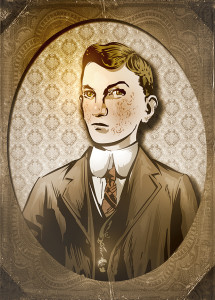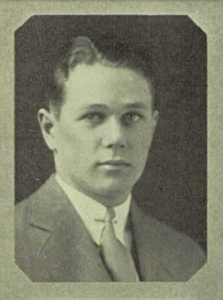
John Rand as interpreted by artist John Kissee. It’s eerie how similar the artist’s portrayal is to the boy’s actual likeness since the yearbook photo to the right wasn’t discovered till after it was completed.

John Crandon as he actually appeared in his senior yearbook picture at Andover High School, MA (1929).
When writing a work of historical fiction, it is incumbent upon the author to make sure the facts are as accurate as possible. When John Kissee sent me his portrait of John Rand (left) for the Piper Houdini website, I wanted to release it to the world with some fun details about the actual individual, similar to what I did with Piper’s father, William Weiss.
Unfortunately, when I was researching Piper Houdini: Apprentice of Coney Island, there was a dearth of information about the enigmatic son of Houdini’s nemesis, Mina Crandon (Margery). So I plugged away on Google to see if any information had been unearthed in the ensuing years. Lo and behold, I came across a curious book called Secrets of the Psychics, by Massimo Polidoro (“Italy’s version of the great Houdini”). In the appendix there is a section called “The Search for Margery: An Interview with the Medium’s Granddaughter.”
Wow!
I obtained a copy of the book and learned that the interview was actually with Margery’s great-granddaughter—a woman named Anna Thurlow, who happened to be John’s granddaughter! (John was an only child.) I also learned, to my dismay, that John’s last name wasn’t Rand as he’s called in the novel. He used his stepfather’s last name, Crandon.
I had known that John was the son of a small-time grocer named Earl P. Rand. I also knew that as a young boy he had run away from home with an English boy whom his stepfather, Dr. Le Roi Crandon, had sought to adopt (a scene which is only slightly modified from actual events in Chapter 4 of the novel). So I wondered why a headstrong boy like this would take the last name of a man he apparently despised.
Well, it turns out that when Dr. Crandon adopted Mina’s son, he not only changed the boy’s last name, he changed his first name as well! (The good doctor had a penchant for changing boys’ names.) John’s original name was Alan Rand!
Damn, damn, damn! Piper’s foil has the wrong name!
So what does one do when writing a book in which one has taken painstaking strides to be historically accurate? If the character in my novel chose to keep the name that Crandon had bequeathed him (which seems incongruous with my portrayal of him), then he would have called himself John Crandon. But if he stubbornly refused the name (which seems more likely), he would have maintained the name bestowed upon him at birth: Alan Rand.
John Howland Crandon never lost the attachment he had to the name Alan. He married a fellow doctor named Dorothy Tebbe and they had a son whom they christened Alan. (This may have been done to spite Dr. Crandon. The couple also had a daughter Mary, possibly named after the daughter Dr. Crandon had from his first marriage whom he disinherited.)
Thurlow states that her grandfather loved Dr. Crandon as much as he feared him. John claimed that he never did one thing against the man’s wishes. Despite the fact that he had no particular desire for medicine, he went into medicine for his sake. “I owe everything I have to him,” he wrote in a letter to his stepsister.
That said, John Crandon’s character was otherwise consistent with how the novel portrays him. Thurlow claims he was a racist and a sexist, but he “hid it well under the veneer of upper-class manners and propriety.” These traits are embodied in John Rand’s treatment of Piper and during his brawl with Sal atop the Kings Theater. He was good-looking (no demonic birth mark) and athletic like his mother (he ran track and was on the wrestling squad). Both of these qualities will be explored more in the next novel.
In this age of electronic publishing, it’s a simple matter to edit your e-book and upload the revised manuscript. You can either announce your revisions to your existing readers or you can simply disregard them and hope they won’t notice. Since there’s no print version of my novel (yet), and the audience for the e-book is still at fledgling levels, I could easily change the character’s name to Alan with little fanfare. But is that an ethical solution? Would I be doing a disservice to readers who have already come to know him as John?
Unfortunately I can’t ask John Crandon. He died on March 7, 2004. So I’m interested in hearing the opinions of other authors and fans of historical fiction. Should I remedy the inaccuracy or leave it alone?
In closing, there’s an amusing anecdote in the interview with Anna Thurlow. When she asked her grandfather how the effects in Mina’s home at 10 Lime Street had been performed, John replied, “Mirrors.” He didn’t explain more than that. Fans of the novel will understand.

The author at 10 Lime Street where John Crandon (a.k.a. Alan Rand) lived with his mother, the infamous Margery.







Interesting dilemma. I think if your goal is historical accuracy and you’ve made a point of selling the book, in part, on your attention to detail, then yes you should edit the ebook and push out a new version. Including an author’s note that acknowledges the change could soothe the concerns of a reader who is confused upon rereading and seeing a new name for John/Alan.